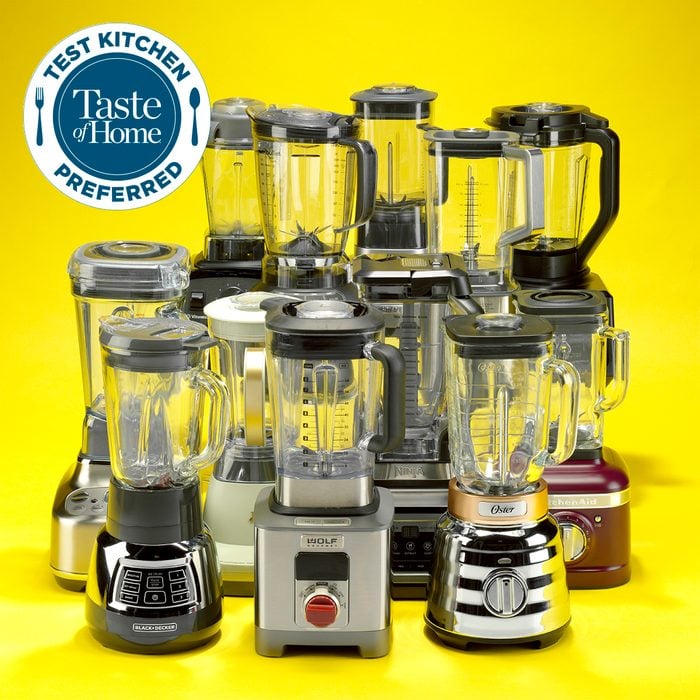
Searching for the Best Blender
If you start every morning with a smoothie, enjoy impressing guests with fancy ice cream drinks or can’t get enough creamy soups during the cooler months, you know how invaluable a blender is.
This countertop appliance is a major part of our kitchen rituals, so it’s important to have a model that really works for you. So what’s the best blender for your morning smoothie bowl, summertime gazpacho and party-ready dips? Our Test Kitchen pros did the research to find out.
How We Tested Blenders
To find the best blenders, our team, led by Executive Culinary Director Sarah Farmer, spent hours in our Test Kitchen making homemade peanut butter, hummus, smoothies, soups, shakes and so much more with 12(!) different blenders. The squad made note of all the blenders’ features and performance and made sure to judge them according to these high-priority categories:
- Functionality: Blenders are super versatile. You can use them to crush ice, make milkshakes, create your own peanut butter and so much more. Our Test Kitchen team put every function on the blenders to the test and tried out a handful of recipes—including this one for the Best Hummus. The pros also made note of how each lid fit into the blender and how the shape of the canisters impacted the results.
- Capacity: When buying a blender, the capacity of the pitcher is a major deciding factor. If you whip up smoothies for a crew every morning, you’ll want a model that holds more. If a blender is more of an occasional gadget for you, a smaller one should do the trick.
- Operation: For a blender to be called the best blender by our Test Kitchen, it should be simple to use with intuitive controls. Extra bells and whistles—think speeds or pulse options—are welcome if they perform well.
- Ease of cleaning: If you ask our Test Kitchen, all gadgets should be easy to clean. Our team of culinarians took note of how to clean each part of these blenders (pitchers, blades, lids and plungers). The easier to clean, the better, and if the parts are dishwasher-safe, that’s the best!
- Appearance: Yes, function, capacity and ease of cleaning all come first with appliances, but if this blender is going to live on your countertop, it should look good there (like this cool retro-looking Frigidaire blender).
- Price: If you’re going to drop a significant amount of money on a blender, it should be worth every penny. Our tests ensure you’re getting the most bang for your buck.
That’s a lot to consider! Our team did it, though, and named a few models their Test Kitchen-Preferred blenders.
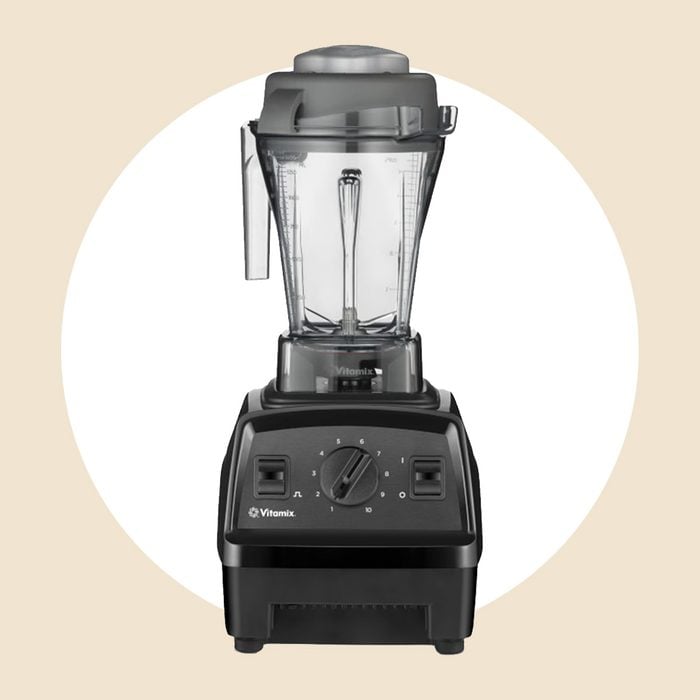 via merchant
via merchant
Best Blender for Smoothies (and More)
Vitamix E310 Explorian Blender
Vitamix has been our Test Kitchen’s go-to for years, and this test only proved what our pros knew all along: The Vitamix E310 Explorian Blender is a top-notch machine.
At first blush, the Vitamix doesn’t look like much—all it has is a simple on/off switch and a speed dial. Don’t let this fool you. The second you flip the switch, you get a powerful blending vortex that transforms a handful of ingredients into perfect Tropical Berry Smoothies or Horchata or Mango Lassi in a matter of seconds. With this power and speed, “it’s no wonder Vitamix blenders were originally made for restaurant use,” says Sarah.
While this luxury kitchen appliance was our Test Kitchen’s favorite for making fresh smoothies and smoothie bowls, it also performed well with all the other tests thrown its way. Frozen margaritas, soups, dips, spreads and more all turned out as desired in this blender without a single hiccup.
Because of this machine’s serious power and performance, Sarah suggests that this is also a great model for folks that are serious about cooking and “are into experimenting with all kinds of food and beverage.” This is a chef-level device and serious cooks will enjoy making use of it in their kitchens.
Pros
What our Test Kitchen liked about the Vitamix blender:
- Incredibly powerful
- Easy to operate
- Sturdy, solid appliance
- Durable and long-lasting
Cons
Consider these factors before you buy:
- On the expensive side for small appliances
- Not the most attractive option
Specs
- 1,400 watts
- Capacity: 48 ounces
- Price: $350
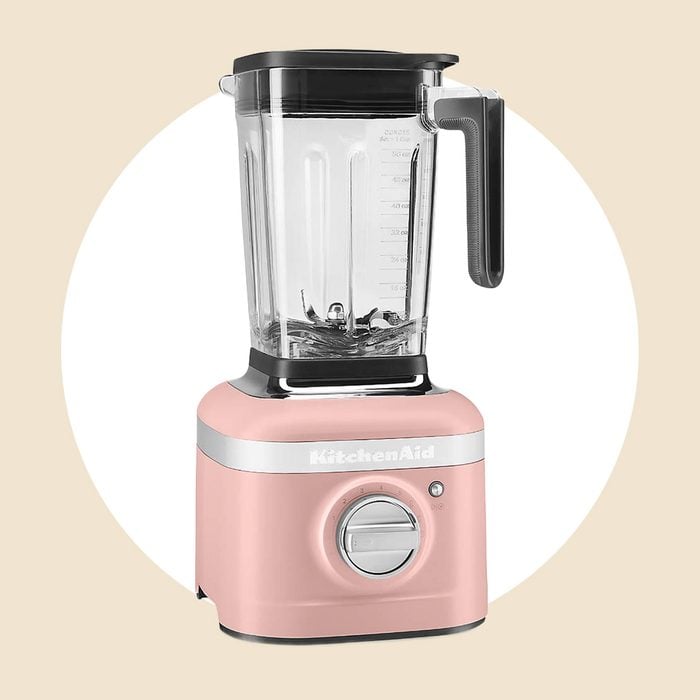 via merchant
via merchant
Best Pretty and Powerful Blender
KitchenAid K400 Blender
Our team knows that your kitchen gear is about more than just performance; we all want our must-have gadgets to look good too. With the KitchenAid K400 Blender, you get the top-notch capabilities and the stunning aesthetics that you expect from this brand.
With 1,200 watts of power, this blender made quick work of so many recipes like this Easy Butternut Squash Soup. Even when working through big batches and on high speed, “it didn’t move, shimmy or shake,” says Sarah. In fact, all our favorite blender recipes were prepped with ease in this KitchenAid blender.
With a sturdy and attractive base—yes, you can get this model in plenty of KitchenAid’s signature colors—this blender delivers on power and blending ability in a big way. Just turn the dial to your desired speed—or one of the three presets—and let this gadget do its work. And with a durable dishwasher-safe pitcher, this is one of those gadgets you’ll be happy to have on your counter for years to come.
Pros
What our Test Kitchen liked about the KitchenAid blender:
- Beautiful; you can get this blender in many colors
- Powerful and sturdy
- Dishwasher-safe pitcher
- Designed and assembled in the USA
Cons
Consider these factors before you buy:
- Square pitcher caused more food splatter and required a little more scraping than other models
Specs
- 1,200 watts
- Capacity: 56 ounces
- Price: $300
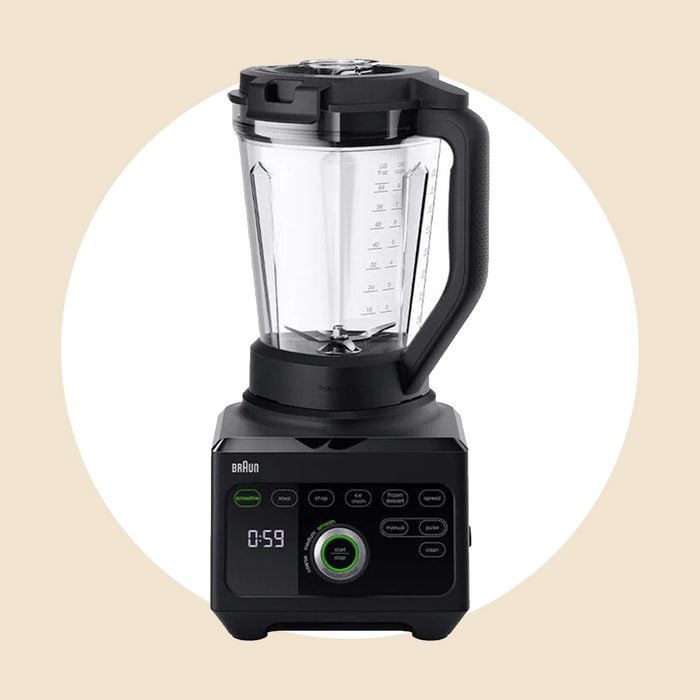 via merchant
via merchant
Most Innovative Blender
Braun TriForce Power Blender
When it comes to gadgets, our Test Kitchen team thought they’d seen it all, but the Braun TriForce Power Blender blew us away. This blender might look like a standard countertop appliance, but it holds a lot of welcome surprises.
This model impressed our Test Kitchen in a big way with some unique design features. First, unlike any other model our team used, this Braun blender features a triangular pitcher. This unusual shape is supposed to force the food down toward the blade for smooth mixes. “The blending results were great,” says Sarah of her tests with this model.
Beyond the unique shape, this Braun blender has all the classic buttons you’d expect of a blender (pulse, puree, etc.), however, it also has a texture control dial. Instead of guessing what combination of pulses and speeds will give you perfect homemade peanut butter, you can just select the desired finish on the dial: smooth, medium or coarse. The machine will take care of all the work without having to stop and check every few pulses. While the blender does the job well, Sarah does recommend staying close to the machine in case you need to tamp down any ingredients with the included plunger.
For even more customization, you can select from a few presets: soup, smoothie, chop, ice crush, frozen dessert or spread. This Braun blender will do all the work for you.
Pros
What our Test Kitchen liked about the Braun blender:
- Helpful texture control dial
- Super powerful
- Super-sharp German blades
Cons
Consider these factors before you buy:
- Expensive
- Loud (even for a blender)
Specs
- 1,600 watts
- Capacity: 68 ounces
- Price: $250
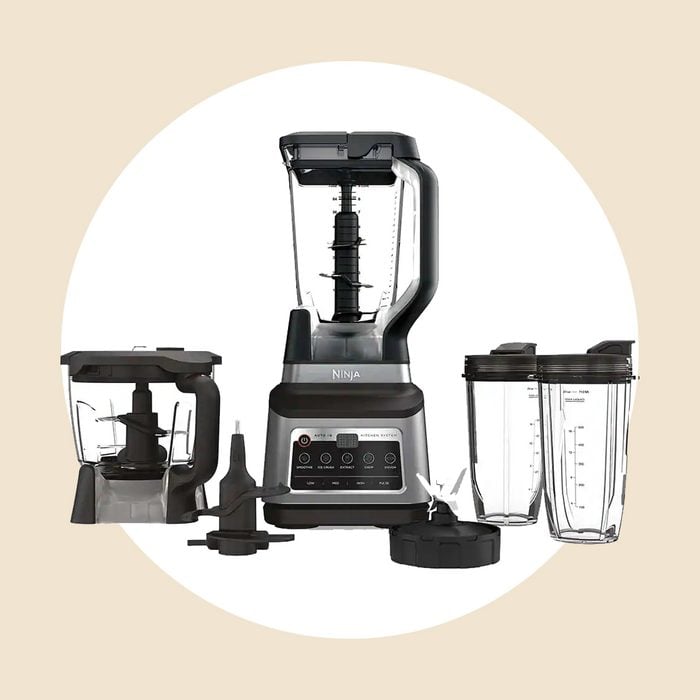 via merchant
via merchant
Best Multipurpose Blender
Ninja Professional Plus Kitchen System with Auto-iQ
Want a blender that does so much more than blend? Add the Ninja Professional Plus Kitchen System with Auto-iQ to your cart.
The basis for this kitchen system is first and foremost a really nice blender. With stacked blades, this Ninja appliance makes short work of ice cubes and purees foods with ease. This blade style wasn’t perfect for smoothies (Sarah compares it to a food processor vs. a blender), but it did so well making recipes like this Contest-Winning Roasted Tomato Soup. When you start making this recipe, you’ll be glad of the Ninja Kitchen System’s large capacity (nine cups!)—everyone will be asking for seconds.
However, if you want to make a single-serve recipe like this Spiced Pumpkin Coffee Shake, you can use one of the included attachments. In the box, you’ll find two blending cups for individual servings. And don’t stop there: Make sure to give the food processor and dough-mixing attachments a try as well.
When you’re done making all your recipes, cleanup is a breeze. All the removable components are dishwasher-safe!
Pros
What our Test Kitchen liked about the Ninja blender:
- Huge capacity; this blender holds up to nine cups
- So many extras; can double as a food processor and single-serve blender
- Supportive, stable base
- Dishwasher-safe parts
Cons
Consider these factors before you buy:
- If you already have a food processor or single-serve blender you love, you don’t need the extra attachments here
Specs
- 1,400 watts
- Capacity: 72 ounces
- Price: $220
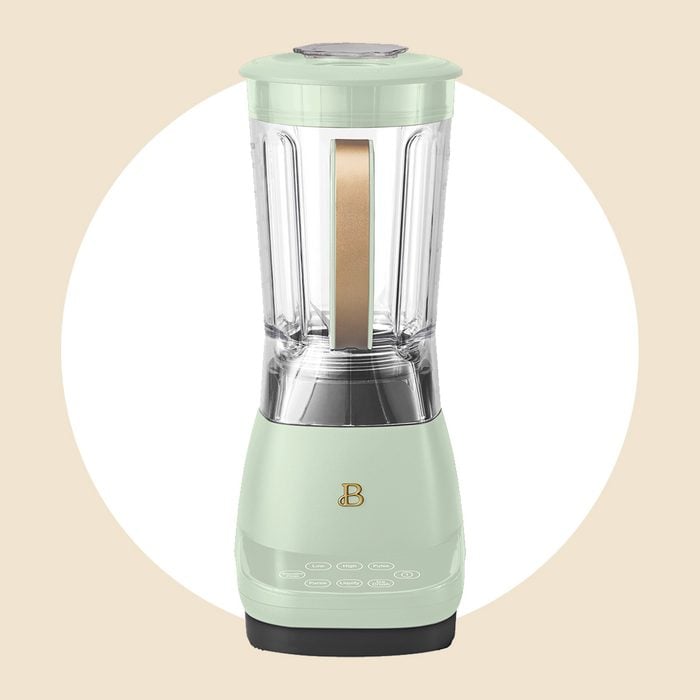 via merchant
via merchant
Best Affordable Blender
Beautiful High Performance Touchscreen Blender
If you’re on a budget or just don’t reach for a blender super frequently, you likely don’t want to drop hundreds of dollars on this sort of appliance. With the Beautiful High Performance Touchscreen Blender, this is no problem at all. This model costs around $60 and held its own among even the priciest blenders in our test.
But before we get into how this blender worked on these Ginger-Kale Smoothies, let’s chat about this Walmart-exclusive brand’s stunning appearance. You can get this Beautiful blender with gold accents in matte black, white, oyster gray, cornflower blue or a pale mint. Our Test Kitchen also really loved the illuminated touchscreen on this model. The display is dark until you give it a tap; then it comes to life and is ready for you to select a setting and a speed.
Now, when it comes to performance, this budget blender really delivered. Smoothies were velvety smooth, the hummus our testers stirred up was wonderfully dippable. The homemade peanut butter was on the crunchy side, but, hey, there’s nothing wrong with chunky peanut butter!
The only place where the Beautiful blender stumbled was with crushing ice. It did the job well producing snowy ice shavings, but the machine had its limits. You can only blend about 10 cubes at a time. If you ask Sarah, just work in batches. This gives your friends time to figure out what flavor snow cone they want.
Want more stunning appliances like this? The Beautiful air fryer is also a Test Kitchen-Preferred pick.
Pros
What our Test Kitchen liked about the Beautiful blender:
- Affordable
- Attractive appearance and sleek touchscreen interface
- Durable, dishwasher-safe pitcher
Cons
Consider these factors before you buy:
- Can only crush about 10 ice cubes at a time
Specs
- 800 watts
- Capacity: 48 ounces
- Price: $66

What We Learned in Our Quest for the Best Blender
Our team spent a lot of time whirring away with these blenders. During the series of tests, they came up with a few key takeaways:
- Power isn’t everything: One thing to know about blenders is that their performance also relies upon the shape of the pitcher. Cylindrical canisters can really help get the ingredients flowing into that vortex for a satisfying mix.
- Poking and prodding are normal: Even the best blenders will require you to stop here and there to scrape down the sides or use the tamper. This is absolutely normal for every model, be it Beautiful, our favorite budget model, all the way up to a spendy Vitamix.
- Read the manual: We mean it! Our team found that in the case of smoothies especially, the order in which you add your ingredients matters. Each blender manual specifies the right order for that model.
- High speed isn’t always the best speed: Switching the blender on high to see your ingredients suddenly blend into one is so satisfying, but this isn’t always the ideal method. Sarah says that some recipes, homemade mayonnaise and dressings especially, benefit from a lower speed.
- Cylindrical canisters are generally the best bet: In our test, only one model with a square-shaped pitcher got our Test Kitchen’s stamp of approval. In general, cylindrical pitchers just funnel the food better toward the blades.

Check Out More Test Kitchen-Preferred Products
Blenders are just the tip of the testing iceberg! Our Test Kitchen is constantly testing kitchen gadgets, cleaning gear and delicious food, looking for brands that deserve the right to be called Test-Kitchen Preferred.
If you’re looking to outfit your kitchen with a few new items, be sure to check out these tests: